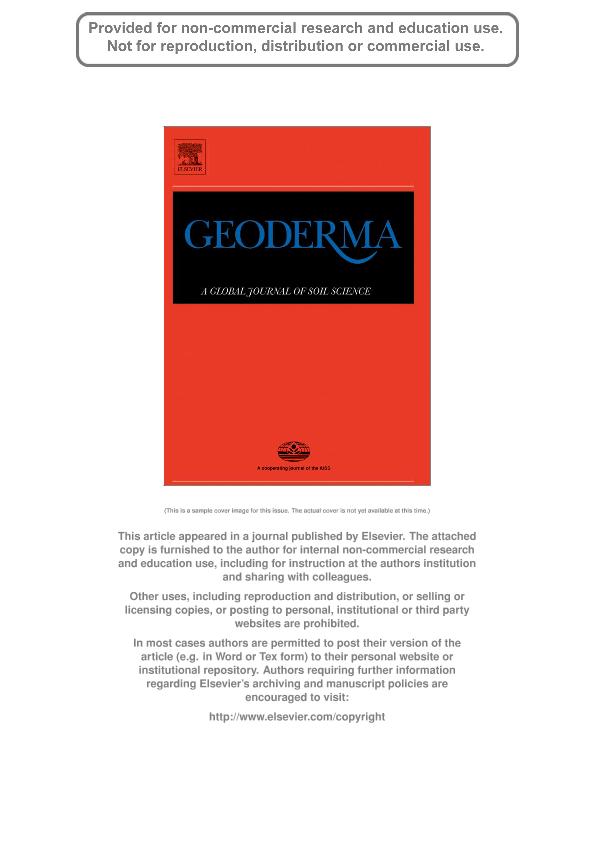Mostrar el registro sencillo del ítem
dc.contributor.author
Wilson, Germán Marcelo
dc.contributor.author
Sasal, Maria Carolina

dc.contributor.author
Caviglia, Octavio Pedro

dc.date.available
2017-09-12T20:20:51Z
dc.date.issued
2013-05
dc.identifier.citation
Wilson, Germán Marcelo; Sasal, Maria Carolina; Caviglia, Octavio Pedro; Critical bulk density for a Mollisol and a Vertisol using least limiting water range: Effect on early wheat growth; Elsevier; Geoderma; 192; 5-2013; 354-361
dc.identifier.issn
0016-7061
dc.identifier.uri
http://hdl.handle.net/11336/24090
dc.description.abstract
The least limiting water range (LLWR) integrates crop growth-limiting values based on easily measurable parameters such as soil water content and bulk density (BD) and has been validated as a valuable soil physical quality indicator for a wide range of soils, crops and management systems. When the LLWR is zero, the soil achieves the critical bulk density value (BDc). Another methodology to assess the level of soil compaction and its effect on crop growth is the shear strength (SS) of the soil. The aims of this work were: i) to obtain critical bulk density values for a Mollisol and a Vertisol using the LLWR and assess their effects on early wheat growth, and ii) to evaluate the variation in early wheat growth as affected by the increases in BD and SS. To this end, an experiment in pots containing disturbed soil from an Aquic Argiudoll and a Typic Hapludert was carried out. Soil cores obtained from agricultural paddocks were mechanically compacted to 1.1, 1.2, 1.3, 1.4 and 1.5 Mg m-3. Wheat was grown on half of the pots for two months, and, after that, both shoot and root biomass were measured. LLWR and SS were evaluated in the remaining non-sowed cylinders as a function of the increase in BD. Critical bulk density was 1.44 Mg m-3 and 1.37 Mg m-3 for the Mollisol and the Vertisol, respectively. Although both soils fit in the same textural class (silty clay loam), the Vertisol has clay dominated by smectite mineralogy. In the Mollisol, wheat growth was limited when BD>1.4 Mg m-3 due to the lack of aeration rather than to the high penetration resistance. In the Vertisol, early wheat growth was not affected by BD due to volumetric changes. Soil shear strength was significantly correlated with BD and was sensitive to soil water changes. Bulk density values higher than 1.35 Mg m-3 had high SS values. This measurement also allowed us to obtain a critical value for crop growth, but only for the Mollisol (50 kPa). When deciding which soil properties should be measured to quantify soil structure or to identify soil quality indicators, SS appears as a fast and operative simple methodology with predictive value of crop response. The concept of LLWR and BDc were useful to determine a threshold for early wheat growth in the Mollisol, but was useless for the Vertisol. These findings provide an interesting plataform for the management of soils with similar textural classes and different clay mineralogy, particularly when they are present in the same paddock across the landscape.
dc.format
application/pdf
dc.language.iso
eng
dc.publisher
Elsevier

dc.rights
info:eu-repo/semantics/openAccess
dc.rights.uri
https://creativecommons.org/licenses/by-nc-sa/2.5/ar/
dc.subject
Critical Bulk Density
dc.subject
Least Limiting Water Range
dc.subject
Soil Shear Strength
dc.subject
Wheat Growth
dc.subject
Vertisol
dc.subject
Mollisol
dc.subject.classification
Otras Agricultura, Silvicultura y Pesca

dc.subject.classification
Agricultura, Silvicultura y Pesca

dc.subject.classification
CIENCIAS AGRÍCOLAS

dc.title
Critical bulk density for a Mollisol and a Vertisol using least limiting water range: Effect on early wheat growth
dc.type
info:eu-repo/semantics/article
dc.type
info:ar-repo/semantics/artículo
dc.type
info:eu-repo/semantics/publishedVersion
dc.date.updated
2017-09-12T16:29:42Z
dc.journal.volume
192
dc.journal.pagination
354-361
dc.journal.pais
Países Bajos

dc.journal.ciudad
Ámsterdam
dc.description.fil
Fil: Wilson, Germán Marcelo. Instituto Nacional de Tecnología Agropecuaria. Centro Regional Entre Ríos. Estación Experimental Agropecuaria Paraná; Argentina. Universidad Nacional de Entre Ríos. Facultad de Ciencias Agropecuarias; Argentina
dc.description.fil
Fil: Sasal, Maria Carolina. Universidad Nacional de Entre Ríos. Facultad de Ciencias Agropecuarias; Argentina
dc.description.fil
Fil: Caviglia, Octavio Pedro. Universidad Nacional de Entre Ríos. Facultad de Ciencias Agropecuarias; Argentina. Instituto Nacional de Tecnología Agropecuaria. Centro Regional Entre Ríos. Estación Experimental Agropecuaria Paraná; Argentina. Consejo Nacional de Investigaciones Científicas y Técnicas; Argentina
dc.journal.title
Geoderma

dc.relation.alternativeid
info:eu-repo/semantics/altIdentifier/url/http://www.sciencedirect.com/science/article/pii/S0016706112002121
dc.relation.alternativeid
info:eu-repo/semantics/altIdentifier/doi/http://dx.doi.org/10.1016/j.geoderma.2012.05.021
Archivos asociados
